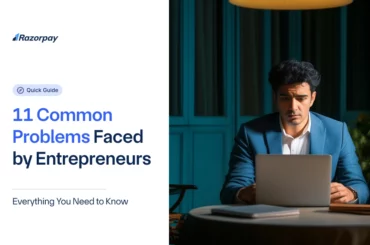We, at Razorpay, had recently organised a webinar on “Disruptive and Cost-effective Marketing Strategies for SMB’s”. The session was quite insightful, especially when everyone around the globe is witnessing a never-seen-before situation. Hope you liked it too!
Missed the webinar? Watch the recording here.
On the 5th of June, MD & Vice-President of GoDaddy, Nikhil Arora, along with Ankit Rawal, Director of Business Development & Partnerships of Affle, and the SME Business Head of Razorpay, Vedanarayan Vedantham, teamed up to talk about effective marketing strategies for small businesses during such difficult times.
The experts provided actionable ways business can adapt to survive and grow during these tough times.
Cost-effective marketing strategies
Nikhil Arora, MD & Vice-President of GoDaddy, stated that retaining new customers is now more important than ever before. It may cost small businesses double the amount to acquire a new customer at this point of time. Instead, small businesses should focus on providing a call to action to existing customers and retain them.
He added that small businesses should be sensitive towards prices. Many customers are facing a liquidity shortage during such times and asking them to pay tons of money would slightly be unfair. The businesses can revise their service/product prices to retain as well as acquire a bunch of customers.
Another marketing strategy to have a look at is Influencer Marketing. This ‘word-of-mouth’ hack has always proved effective for improving conversion rates and brand credibility. Businesses can collaborate with an online influencer to market their products or services. These influencers can be anywhere and can be anyone. It’s their large followings on the web and social media that makes them influential.
Lastly, Nikhil shared an interesting marketing hack of customised webinars to engage existing customers. This strategy involves customising webinars for a small bunch of your customers and engaging them to understand their point of view about the market, products and services, and your offerings.
Ankit Rawal, Director of Business Development & Partnerships of Affle, also provided some cost-effective marketing tips to acquire customers in the new normal.
One of the tips for small businesses is using a combination of “owned, earned and paid media”. Businesses should use one media channel to amplify another channel. The channels will give optimal results only when used hand-in-hand.
Are the terms new for you too?
Don’t worry, we are here to make you understand in the simplest way.
| Media Channel | Definition | Examples | Role in businesses |
| Owned Media | Channel that a brand/business controls itself | Website
Blog Facebook account Twitter account |
Builds a long-term relationship with existing potential customers and earn media |
| Paid Media | Brand/businesses pay to leverage a channel | Display ads
Sponsorship Paid search |
Shift from organisation to a catalyst that inspires owned and creates earned media |
| Earned Media | When your customers become a channel | Word of mouth
Buzz Viral content |
It is the result of well-coordinated and well-executed owned and paid media |
Now, you know which media channel to use for acquiring customers in a scalable cost-effective manner.
Ankit also stated that providing discounts or slashing product prices might attract existing as well as new customers. Everybody, be it a business or an individual, is going through tough times due to COVID-19 outbreak. Providing price cuts or discounts can boost their morale to use a particular product or service over its competition.
The discussion on cost-effective marketing strategies was concluded by Vedanarayan Vedantham, SME Business Head of Razorpay in the webinar. He stated the four pillars of effective social media marketing is earned media, virality, word of mouth, and community building.
Stakeholders on the new normal
The panel also discussed the impact of operating in the new normal on different stakeholders of the business during the webinar.
First ones impacted are employees. The new normal of working from home has changed the way employees operate and collaborate with peers, colleagues and customers. Some of them are comfortable with working from home, while others are finding it difficult. Since the pandemic has created havoc around the world, small business owners need to motivate their employees to remain competitive.
Corporate/business leaders have also been impacted by the new normal. Be it an 18-year-old business owner or a 60-year-old, both of them are striving for successful leadership attributes in the present time. Business owners/leaders are trying to tackle the never-seen-before situation with their own set of perceptions based on their past experiences and current market knowledge.
Impact on digitisation curve
For the last few years, the digitisation curve was moving forward at a normal pace. As social distancing is the new normal for individuals and businesses, digital adoption is growing rapidly all over the world.
One of the panellists, Ankit Rawal, said that geography is becoming a new history!
The businesses are no more limited to a geographical area. With the presence of digital solutions, the owners are expanding their businesses to far-away places. This new way of operating is also responsible for a huge spike in the digitisation curve.
Growing industries in the new normal
According to our panel of experts, here are the few industries that will witness huge growth in the new normal:
- Education Technology (EdTech)
- Health Technology (HealthTech)
- Supply Chain Management
- Transportation Industry
- Private-public Partnerships
- Financial Technology (FinTech)
- Gaming Industry
This is all from our experts! Thank you for attending the webinar or reading it. Sign up with us to know what’s coming up next.
Stay tuned! Stay safe!





